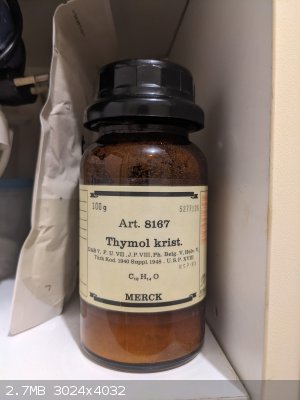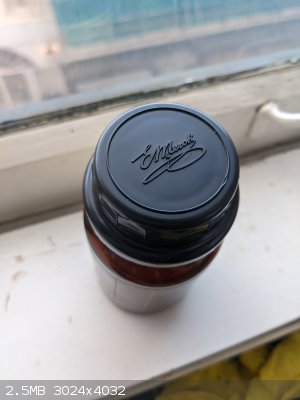Tsjerk
International Hazard
    
Posts: 3022
Registered: 20-4-2005
Location: Netherlands
Member Is Offline
Mood: Mood
|
|
Chemistry to do with thymol
I have a lovely looking bottle of thymol, and I have been wondering about what to do with it for 15 years now, it comes from my first bulk buy of
chemicals.
First question; could it really be from 1948? I don't understand the labelling.
Second: I want to use it to make some pH indicators and dyes, which are both interesting. But which should you make?
I thought about the obvious of course, thymolsulfonephthalein and bromo thymolsulfonephthalein, but I really don't know anything about indicator/dye
chemistry. Does anyone know about some articles on any of the chemistry I could do with thymol?

|
|
|
Texium
Administrator
       
Posts: 4516
Registered: 11-1-2014
Location: Salt Lake City
Member Is Offline
Mood: PhD candidate!
|
|
Thymolphthalein would be the simplest one to make. It is made analogously to phenolphthalein, with phthalic anhydride and an acid catalyst, but with
thymol in place of phenol.
|
|
|
unionised
International Hazard
    
Posts: 5104
Registered: 1-11-2003
Location: UK
Member Is Offline
Mood: No Mood
|
|
The label says it complies with the 1948 version of the pharmacopeia or some such.
|
|
|
SWIM
National Hazard
   
Posts: 970
Registered: 3-9-2017
Member Is Offline
|
|
USP XIX was published in 1975.
They are generally published every five years, so the original print on the label is probably from 1970-1975.
The 1948?
Maybe the Turks haven't needed to update their codes for drug standards as often.
Or since 1948 appears to be a supplement perhaps that was the last supplement before 1975 that included a change in the requirements for thymol.
No point in mentioning later supplements if they don't involve this compound.
I've pretty much forgotten all the Turkish I ever knew, so further research on this would be difficult.
[Edited on 22-11-2021 by SWIM]
So since the USP is published as a complete work every 5 years or so I would bet that your thymol was bottled between 1975 and 1980, and they added
the XIX codex to the label at that time because it wasn't worth printing a new one.
Or maybe it was bottled in 1970-1975 and they didn't sell it until after the new USP was published and so added the XIX stamp.
[Edited on 22-11-2021 by SWIM]
|
|
|
DraconicAcid
International Hazard
    
Posts: 4278
Registered: 1-2-2013
Location: The tiniest college campus ever....
Member Is Offline
Mood: Semi-victorious.
|
|
I strongly suspect that you could diazotize any aromatic amine and couple it to thymol to get an azo dye. Thymol being slightly acidic, the dye
should change colour around a pH of 9 or 10. (Not an organic chemist disclaimer.)
Please remember: "Filtrate" is not a verb.
Write up your lab reports the way your instructor wants them, not the way your ex-instructor wants them.
|
|
|
karlos³
International Hazard
    
Posts: 1520
Registered: 10-1-2011
Location: yes!
Member Is Offline
Mood: oxazolidinic 8)
|
|
To me, the cap says no, but then again, the label says no younger than the 60-70s.
verrückt und wissenschaftlich
|
|
|
Tsjerk
International Hazard
    
Posts: 3022
Registered: 20-4-2005
Location: Netherlands
Member Is Offline
Mood: Mood
|
|
Thanks for the answers, I will have a lookout for an aromatic amine as I have never done a diazotization before anyway. And some phthalate as I ran
out on it while making thalidomide.
@karlos: I have some more bottles from that same buy which have the same caps, they look the same as they did 15 years ago. And I have stored them in
a place without ventilation with acids and bases fuming their way around. Some labels in the same closet went black or colorless. But these caps look
like they do, must be some propper quality stuff.
[Edited on 23-11-2021 by Tsjerk]
|
|
|
karlos³
International Hazard
    
Posts: 1520
Registered: 10-1-2011
Location: yes!
Member Is Offline
Mood: oxazolidinic 8)
|
|
They look typical to what you often see in pharmacies in germany, as decoration though.
But I remember I once had a Merck bottle of sodium pyruvate(I bought some anew and put it among the same chems) and the label kept well.
The labels that turned black, where they from Tom, I mean, onyxmet?
He's the only one I experienced such a thing with, what does he even make his labels from? 
Maybe recycled toilet paper? 
When I buy at him the next time, I might write a note about it.
[Edited on 23-11-2021 by karlos³]
verrückt und wissenschaftlich
|
|
|
pantone159
National Hazard
   
Posts: 586
Registered: 27-6-2006
Location: Austin, TX, USA
Member Is Offline
Mood: desperate for shade
|
|
As far as labels going blank/colorless: I have experienced this with some things from ChemSavers. The label kind of seems to be made by a cheap
printer, and over time it fades to become unreadable. I don't know if this is related to any fumes or not. It is not a good behavior for a chemical
label.
|
|
|
karlos³
International Hazard
    
Posts: 1520
Registered: 10-1-2011
Location: yes!
Member Is Offline
Mood: oxazolidinic 8)
|
|
Word.
Thats pretty bad in some cases.
Thinking of the dichromate I could only make out because it was purple after screwing it open.
I think its the presence of slight solvent fumes(because it happened different to different cartons of chemicals, always related to the presence of
solvents, even if in a bottle) and cheap printer ink.
Something like this.
verrückt und wissenschaftlich
|
|
|
SWIM
National Hazard
   
Posts: 970
Registered: 3-9-2017
Member Is Offline
|
|
The foolproof way to label a glass bottle:
Use an engraving pen.
|
|
|
Tsjerk
International Hazard
    
Posts: 3022
Registered: 20-4-2005
Location: Netherlands
Member Is Offline
Mood: Mood
|
|
I know why that cap on the thymol bottle looks as it does, it is proper German.

The most blackened labels are from laboratoriumdiscounter, but hey, they are cheap.
[Edited on 25-11-2021 by Tsjerk]
|
|
|
Boffis
International Hazard
    
Posts: 1836
Registered: 1-5-2011
Member Is Offline
Mood: No Mood
|
|
OK Guys, I think that's enough of the side show! The label on the IP bottle is quite clear. Now can we have some actual chemistry?
Vogel's 3rd edition has the preparation of o-sulphobenzoic anhydride and phenol red. I suspect that thymol would substitute directly for the phenol.
The main problem here is the conversion described by Vogel of saccharin into sulphobenzoic anhydride requires thionyl chloride but somewhere I have
seen that acetic anhydride or acetyl chloride can be used to prepare the anhydride.
Have you ever tried to nitrate it and then reduce to an amine or oxidize it to thymol quinone and then to all the compounds that can be prepared from
quinones
Magpie also posted a preparation of thymolphthalein which I think would also work with zinc chloride.
|
|
|
Tsjerk
International Hazard
    
Posts: 3022
Registered: 20-4-2005
Location: Netherlands
Member Is Offline
Mood: Mood
|
|
Thank you for the chemistry reminder Boffis. I will do some chemistry and report back later.
|
|
|
Bedlasky
International Hazard
    
Posts: 1219
Registered: 15-4-2019
Location: Period 5, group 6
Member Is Offline
Mood: Volatile
|
|
You can use it for Berthelot test for ammonia.
https://www.sciencemadness.org/whisper/viewthread.php?tid=74...
|
|
|
DraconicAcid
International Hazard
    
Posts: 4278
Registered: 1-2-2013
Location: The tiniest college campus ever....
Member Is Offline
Mood: Semi-victorious.
|
|
I wonder if it can be oxidized to methylsalicylic acid or hydroxyterphthalic acid. You'd probably need to turn the hydroxyl into an alkoxy group
first, to prevent oxidation into a quinone.
You could probably also turn it into an ester using an anhydride- might smell nice.
[Edited on 30-11-2021 by DraconicAcid]
Please remember: "Filtrate" is not a verb.
Write up your lab reports the way your instructor wants them, not the way your ex-instructor wants them.
|
|
|
Tsjerk
International Hazard
    
Posts: 3022
Registered: 20-4-2005
Location: Netherlands
Member Is Offline
Mood: Mood
|
|
I ordered phthalic anhydride, aniline and toluidine.
|
|
|
nezza
Hazard to Others
  
Posts: 324
Registered: 17-4-2011
Location: UK
Member Is Offline
Mood: phosphorescent
|
|
As Draconic Acid suggested it reacts with diazotised aniline or sulfanilic acid easily to produce orange or yellow dyes.
If you're not part of the solution, you're part of the precipitate.
|
|
|
DraconicAcid
International Hazard
    
Posts: 4278
Registered: 1-2-2013
Location: The tiniest college campus ever....
Member Is Offline
Mood: Semi-victorious.
|
|
Also, phenol can be converted to salicylic acid with carbon dioxide. You should be able to do a similar reaction with thymol.
Please remember: "Filtrate" is not a verb.
Write up your lab reports the way your instructor wants them, not the way your ex-instructor wants them.
|
|
|
Tsjerk
International Hazard
    
Posts: 3022
Registered: 20-4-2005
Location: Netherlands
Member Is Offline
Mood: Mood
|
|
Saccharine can be converted to o-sulphobenzoic anhydride by heating it in sulfuric acid, which can be reacted with thymol to thymol blue, which is a
nice indicator by itself, but which can also be brominated with bromine in glacial acetic acid to bromo thymol blue. Which is an even nicer
indicator.
I also found a sweetener which is sold around here which is pressed sodium saccharine.
Attachment: tillu2012.pdf (282kB)
This file has been downloaded 186 times
[Edited on 15-12-2021 by Tsjerk]
|
|
|
Boffis
International Hazard
    
Posts: 1836
Registered: 1-5-2011
Member Is Offline
Mood: No Mood
|
|
Hi Tsjerk, that paper is an interesting find. That method beats the pants off making o-sulphobenzoic anhydride from sodium saccharin and does require
thionyl chloride or acetic anhydride.
Has anyone here ever tried the direct nitration of thymol? In an Indian chemistry book by Arun Sethi he describes the tri-nitration of thymol but I
find this difficult since this would entail an ortho, a meta and a para nitro-substitution relative to the OH. My experience of the nitration of
thymol is a dark brown viscous reaction mixture from which I could extract nothing.
|
|
|